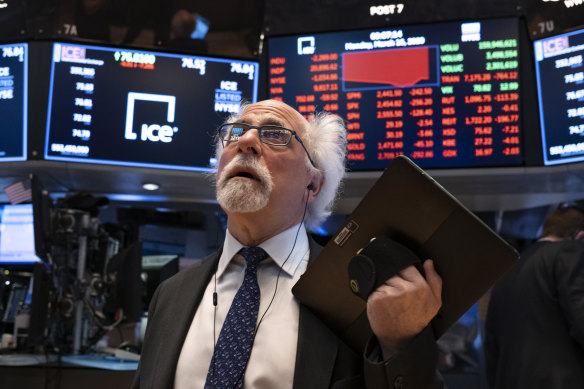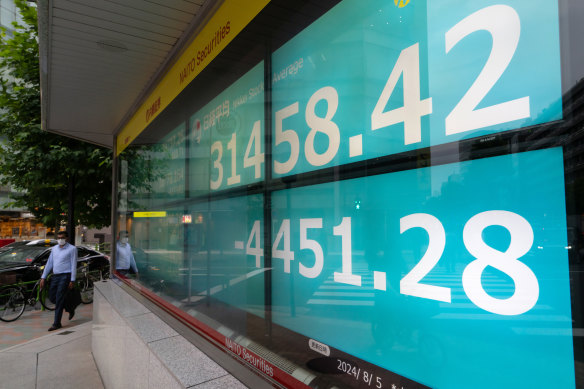Opinion
Butterfly effect: What sparked the global market meltdown
Stephen Bartholomeusz
Senior business columnistIt seems irrational that a single data release in the US could set loose a kaleidoscope of butterflies in global financial markets, from New York, to Tokyo, Mexico to Sydney. In just a few days since that US jobs number was released, however, chaos has erupted in global markets.
Stock markets from New York to Tokyo have been sold off heavily (Tokyo gut-wrenchingly), currency markets have been upended, commodities have been dumped and bond yields have tumbled.

Wall Street’s benchmark index just recorded its worst day in nearly two years.Credit: AP
It’s a perfect illustration of the butterfly effect, where an apparently minor event triggers something quite dramatic elsewhere. In this case, it underscores how deeply globalised, interconnected, fragile and vulnerable to surprises financial markets are.
The catalyst for the chaos of the past few days was last week’s US jobs report for July, which showed only 114,000 jobs were created, well short of expectations of a number closer to 175,000.
That suggested that the US economy was softening faster than previously recognised and that the US Federal Reserve, which kept US interest rates on hold earlier in the week, had fallen behind the curve and risked a hard landing – a recession – in the world’s largest economy.
By itself, that would have been enough to cause a sell-off of US stocks, particularly the mega tech stocks that, driven by the excitement around artificial intelligence, were priced for perfect outcomes.
The US sharemarket, after a massive surge since the AI frenzy gathered pace late last year, was vulnerable to any bad news and the centrality of US financial markets to global financial flows ensured that volatility in those markets would have global spillover effects.
The release of the employment data, moreover, coincided with the Bank of Japan’s decision last week to lift Japan’s interest rates and wind back its long-running purchases of Japanese government bonds.
The yen, under pressure last month to the point that the Bank of Japan was forced to intervene to prop it up, had already started to strengthen in anticipation of the central bank’s tightening of monetary policy.
After the US jobs report precipitated a depreciation of the US dollar against the currencies of its major trading partners, the yen continued to surge.
During Japan’s long period of zero to negative interest rates, so-called “carry trades” have flourished.
Japanese investors, including savings-rich households, have invested in higher-yielding assets offshore while foreign investors have borrowed very cheaply in Japan to do the same, buying US bonds and equities or higher-yielding currencies like Mexico’s peso – or the Australian dollar.
The sudden compression of market bond yields, with Japanese yields firming and US yields weakening, and the strengthening of the yen against the dollar, generated margin calls on leveraged hedge fund investors in those trades and wiped out much of the relatively small margins that the trades offered, forcing a mass exodus from what were very popular and highly concentrated trading strategies.

Japan’s Nikkei plummeted by double digits on Monday. Credit: Getty Images
The shifting interest rate and currency relativities also triggered a meltdown of Japan’s stock market, which plummeted 12 per cent in a day, its worst one-day fall since the 1987 sharemarket crash that marked the start of Japan’s long economic winter.
Since peaking at record levels less than a month ago, Japan’s sharemarket has fallen about 25 per cent, with a near-20 per cent decline since the start of this month.
The US and Japanese currencies are two of the most heavily traded (numbers one and three, with the euro sandwiched between them) and their stock and currency markets are influential globally. It isn’t surprising, therefore, that their volatility infected markets worldwide.
Has the rout in markets been an over-reaction? It would seem so.
While the US jobs data disappointed, and suggested that the Fed misread the economy when it left US rates unchanged last week, the US economy has been posting reasonably solid growth – it grew at an annualised rate of 2.8 per cent in the June quarter – and data released in the US on Monday showed that its services sector, which had been contracting, is growing again and adding jobs.
That moderated the falls in the US market and seems to have calmed international equity markets for the moment.
While the more panicky investors in the US have called for an emergency rate cut from the Fed, and the markets are now pricing in up to 1.5 percentage points of rate cuts before the end of the year, which would suggest at least two “jumbo” 50 basis points cuts at the final three meetings, the Fed is unlikely to succumb to that panic. Indeed, a move outside the scheduled meetings would be interpreted as a sign that the Fed itself was panicking.
In the absence of data to the contrary, the Fed is more likely to stick to its own expectation of a 25 basis point cut in September and maybe another one or two of similar size by the end of the year.
If you step back from the chaos of the past few days it would seem reasonable to conclude that sharemarket valuations had been pushed too far.
The AI-driven boom in the big tech stocks had started to deflate as it has become clear that vast amounts of capital will be consumed before revenues commensurate with that investment can be generated, if they are generated. The US economy has slowed and, while quarterly earnings numbers have been solid, they haven’t been impressive enough to justify inflated valuations.
That made them vulnerable to any negative news.
Sell-offs as violent as the one we’ve seen in the past few trading days, however, do have real effects.
They do affect confidence and spending and do have wealth effects. They make investors and lenders more risk-averse, which can spill into the levels of activity in real economies as financial conditions tighten.
They can also have unexpected consequences.
When so much borrowed money is focused on a handful of carry trades, their unwinding can generate substantial losses within the opaque corners of the shadow banking system – the hedge funds and asset managers that financial regulators have been increasingly worried about.
It is conceivable, albeit not probable, that something could break within that shadow system of non-bank institutions with wider implications for system stability.
That – something akin to the Long-Term Capital Management crisis in 1998, or the Archegos Capital implosion in 2021 – would provide a reason for the Fed and its global peers to intervene with rate cuts and infusions of liquidity.
At the moment, however, this looks like something of a markets-contained event, an extreme overreaction to one data point, coming after several weeks of emerging scepticism of the sharemarkets’ fundamentals, that wasn’t as dire as the reaction to it might suggest. Let’s hope that is all that it is.
The Market Recap newsletter is a wrap of the day’s trading. Get it each weekday afternoon.